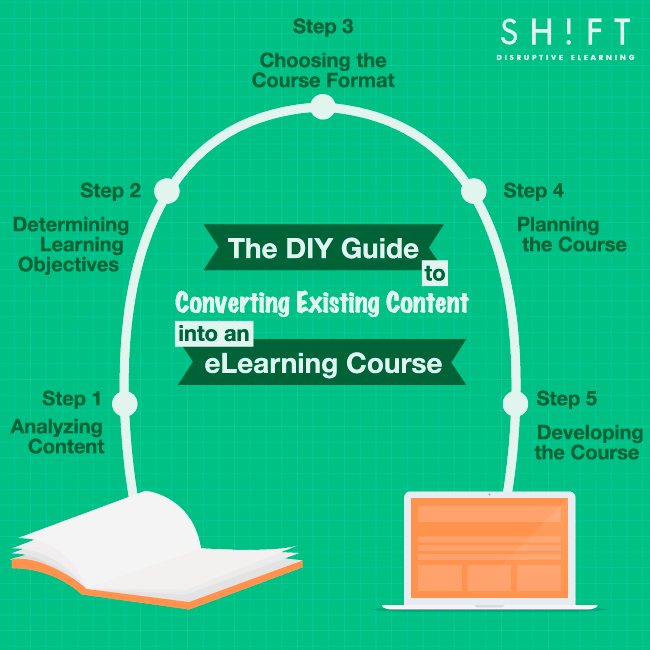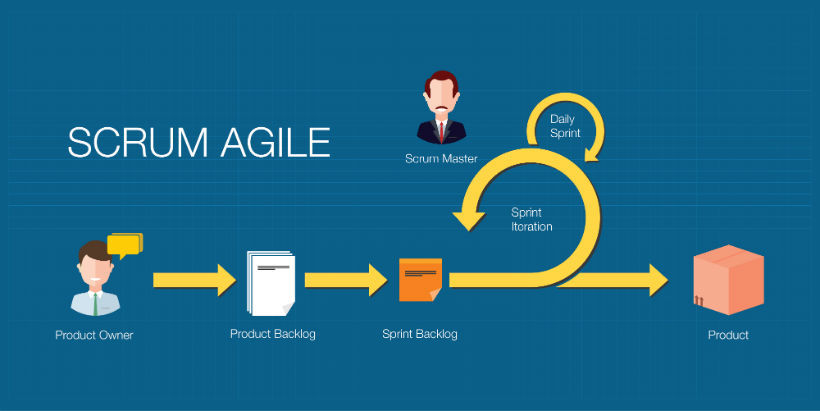To create an eLearning course, do some prep work, organize the work with SMEs and stakeholders, make a course outline, create a course storyboard, write a script, and put the content together. Record or add audio and video, add assessments and knowledge checks, and decide where to host your online course.
Creating an eLearning course can be an effective way to provide education or training to a large audience. Whether you are an educator or a business owner, developing an eLearning course can help you engage with your audience and deliver information in an interactive and effective manner.
However, designing an eLearning course can be overwhelming and challenging. It requires careful planning, preparation, and attention to detail. We will explore some tips and guidelines to help you create an eLearning course that engages your learners and achieves your intended outcomes.

Credit: elearningindustry.com
Understanding Elearning Course Creation
Learn how to create an elearning course with expert guidance from online resources and training programs. Develop an outline, organize your content, create interactive elements, and evaluate your course to ensure it meets the needs of learners.
Introduction
When it comes to creating an eLearning course, there are several factors to consider, from planning to execution. Understanding eLearning course creation is key to creating courses that are engaging, informative, and effective. In this post, we will explore the importance of eLearning courses, why they are necessary, and how to plan your eLearning course creation to ensure a successful outcome.
Why Elearning Courses?
eLearning courses have become increasingly popular over the years, and for good reason. They offer learners the flexibility to learn at their own pace, on their schedule, and from anywhere in the world. eLearning courses are also cost-effective, as they eliminate travel and accommodation expenses and can be updated quickly and easily. Additionally, eLearning courses offer a range of multimedia options, such as videos, graphics, and interactive quizzes, making it easier for learners to engage with and retain the information.
Planning Your Elearning Course Creation
To create a successful eLearning course, it’s essential to plan your course creation carefully. This involves identifying your learning objectives, determining your target audience, creating a course outline, and selecting appropriate content delivery methods. Consider using a needs analysis to identify any existing gaps in knowledge or skills that the course should address. Once you have identified your goals and objectives, you can develop your course content, structure, and delivery methods.
To create a successful eLearning course, you may consider choosing from a variety of eLearning authoring tools available in the market. These tools can help you create interactive and engaging eLearning content with minimal to no coding skills such as Adobe Captivate, Articulate Storyline, and Lectora Inspire.
In conclusion, understanding eLearning course creation is essential to creating effective and engaging courses. With proper planning and execution, you can create courses that meet the needs of your audience, and provide them with an enjoyable and educational experience.
Designing Your Elearning Course
Creating an eLearning course can seem overwhelming, but following a clear process can make it more manageable. First, plan and organize your content, then develop a storyboard, script, and interactive elements. Finally, record and edit the content and add assessments.
Designing an eLearning course is a crucial step as it sets the tone for an engaging and comprehensive learning journey. Any great instructional designer knows that designing an eLearning course should be well thought out to ensure that the course is engaging, informative, and visually appealing. We have listed below the top three considerations to keep in mind when designing your eLearning course.
Creating A Course Outline
Creating a course outline is the first step when it comes to designing an eLearning course. This will guide the instructor in creating a well-structured and organized course. To create an outline, the instructor can begin by listing all the topics that should be covered in the course. Once the topics are listed, they can be organized in a logical sequence of learning. Additionally, the outline should indicate where interactive elements, such as quizzes and polls, will be included, and also the flow of the course.
Developing A Storyboard
Developing a storyboard helps to visualize the layout of each screen and create a roadmap for course development. A storyboard is a visual representation of what the course will look like, and how the information will be presented to the learners. For instance, the storyboard will include the text, images, and interactive elements on each page. A well-designed storyboard ensures consistency in the course and helps eliminate any confusion during the development of the course.
Adding Interactivity
Adding interactivity elements in an eLearning course, notifies learners when they start drifting away. This composed approach can captivate learners, steers concentration, and ensures they complete the course. Fortunately, numerous interactive elements can be added to a course, including quizzes, videos, surveys, and engaging animations.
In summary, designing an eLearning course is not a straightforward and simple task; it requires careful consideration and collaboration between an instructional designer and subject-matter specialists. Creating a course outline, developing a storyboard, and adding interactivity, are the top considerations when designing an eLearning course. By following these essential guidelines, you can design an eLearning course that is engaging and informative, and learners will complete with ease.
Creating Elearning Course Content
Create an eLearning Course? To create an eLearning course, start with outlining your course topics, identifying interactivity and course flow. Organize your work with SMEs and stakeholders, create a storyboard and script, put the content together, and add assessments and knowledge checks.
Finally, record or add audio and video for an engaging course.
Creating Elearning Course Content is essential to ensure your learners receive a comprehensive and engaging learning experience. In this section, we will discuss the important aspects of creating elearning course content. The sections we will cover include Organizing Course Topics, Writing a Script, Recording Audio and Video, and Adding Assessments and Knowledge Checks.
Organizing Course Topics
Organizing Course Topics is the first step towards creating an effective elearning course. Start by listing down all the topics you want to cover in your course. Once you have a list, it’s important to organize them in a logical order to ensure that learners receive information in a progressive manner. You can use tools like mind maps, flowcharts, and storyboards to help you in organizing the topics. By clearly defining the journey, your learners take from one topic to the next, you can make the learning process much more engaging.
Writing A Script
Writing a Script is an important part of developing elearning content. It helps bring structure to the course and ensures that your content is on point. A script should detail exactly what you will cover in the course, including the objectives, the key points you want to make, and how you intend to make them. When writing a script for elearning, make sure to keep it concise and simple. Break it down into small sections, each dealing with one point so that learners can easily follow and grasp the concepts.
Recording Audio And Video
Recording Audio and Video brings your content to life. Depending on your course’s design, you may need to create and series of videos or audios to enhance the learner’s understanding. In recording audio and videos, aim for high-quality, clear audio and images. This will ensure that your learners can follow your content with ease. Utilize tools like screen recording software, microphones, and tripods to create high-quality media for your learners.
Adding Assessments And Knowledge Checks
Adding Assessments and Knowledge Checks is essential to evaluate the effectiveness of your elearning course content. It also helps learners to self-assess their understanding of the content. To create assessments and knowledge checks, decide on the type of evaluation you’re looking to carry out. You can use tools like quizzes, polls or surveys, and essays. Ensure that your evaluations are directly tied to the course’s objectives to make them more relevant.
In conclusion, Creating Elearning Course Content involves several crucial steps like organizing course topics, writing a script, recording audio and video, and adding assessments and knowledge checks. When done effectively, your content can help learners achieve their learning objectives while enjoying the learning process.
Tools For Elearning Course Creation
Create an engaging elearning course by utilizing tools such as SkyPrep’s customizable LMS, and following the design and development process outlined in the eLearning Designer’s Academy by Tim Slade, which includes steps such as conducting a needs analysis, drafting a storyboard, and creating interactive elements.
You can also create a course outline and add assessments and audio/visual components to enhance the learning experience.
Ispring Solutions
The iSpring Suite is a popular eLearning authoring toolkit that allows users to produce interactive eLearning content without the need for coding skills. The platform provides pre-built templates and themes to help users speed up their development process. It is equipped with features such as narration recording, integration with PowerPoint, quizzes and surveys, and screen recording. iSpring Suite also supports HTML5 and SCORM formats, ensuring compatibility with most Learning Management Systems.
Continu
Continu is an all-in-one learning management system that offers custom eLearning course creation and management capabilities. With its intuitive and user-friendly interface, users can easily author, publish, and manage their online courses without technical expertise. Continu also includes features such as social learning, built-in feedback and analytics, and personalized learning paths for each user. The platform integrates with several third-party tools, such as Google Drive and Dropbox for seamless course content delivery.
Shiftelearning.com
Shiftelearning.com offers a cloud-based platform for authoring and publishing eLearning courses that can be used on any device. The platform provides access to a comprehensive library of templates, themes, and video tutorials to help users create dynamic and engaging content. Shiftelearning.com also includes interactive quizzes, simulations, and gamification to enhance the learning experience. With its built-in analytics and reporting tools, users can track learner progress and fine-tune their courses for maximum impact.
When it comes to creating your own eLearning course, it’s crucial to select the right tools that best align with your needs and goals. iSpring Solutions, Continu, and Shiftelearning.com offer unique features and capabilities that can help bring your content to life. Consider exploring each of these options to determine which platform is the best fit for your project.
Cost Considerations For Elearning Course Creation
Creating an eLearning course involves various cost considerations such as content development, learning management system, multimedia production, and delivery platforms. With proper planning, budgeting and prioritizing, the course creation process can be streamlined, cost-effective and highly impactful.
Elearning courses are one of the most convenient ways for people to gain knowledge and skills from the comfort of their own homes. However, creating an eLearning course is not as easy as simply compiling a PowerPoint presentation. There are many factors to consider, including the cost. In this section, we will discuss cost considerations for eLearning course creation. We will look at the factors that affect cost and the cost analysis of eLearning course creation.
Factors Affecting Cost
There are several factors that affect the cost of creating an eLearning course. These factors are:
- Content: The amount and complexity of the content that needs to be included in the course can affect the cost. If the content is technical and requires extensive research, the cost may be higher.
- Animations and Interactivities: The more animations and interactivities that are required in the course, the more expensive it will be to create. These elements require skilled designers and developers to create.
- Technology: The technology used to create the course can also affect the cost. Some technologies are more expensive than others.
- Experience: The level of experience of the eLearning course creator also affects the cost. Experienced course creators may charge more than novices.
Cost Analysis Of Elearning Course Creation
The cost of creating an eLearning course can vary widely depending on the complexity of the course and the quality of the final product.
| Cost Element | Low | Mid | High |
|---|---|---|---|
| Content Development | $500 | $1,500 | $5,000 |
| Graphic Design | $500 | $1,500 | $5,000 |
| Animations/Interactivities | $500 | $1,500 | $5,000 |
| Technology and Hosting | $50/month | $100/month | $200/month |
| Total Cost | $1,550 | $4,000 | $15,200 |
Note that these are estimates and the actual cost can vary greatly.
Creating an eLearning course can be expensive, so planning and budgeting are important. Keep in mind the factors affecting cost and use a cost analysis to determine the best budget for your needs. By doing so, you can create a high-quality eLearning course that effectively delivers your content, engages learners, and meets your budget.

Credit: www.shiftelearning.com
Marketing And Selling Your Elearning Course
Learn how to create an eLearning course with these helpful tips on marketing and selling your course. From organizing your content to creating a course outline, this guide covers everything necessary to captivate learners and scale your training. Take insights from industry professionals to design eLearning that engages learners and promotes success.
Marketing and Selling Your eLearning Course
Once you have created your eLearning course, the next step is to market and sell it to your target audience. This can be a daunting task, but with the right strategies and tools, you can effectively reach and convert potential learners into paying customers.
Choosing a Business Model
Before you start marketing your eLearning course, it’s important to choose the right business model for your course. There are various models to choose from, including subscription-based, one-time purchase, pay-per-course, and freemium. Consider your target audience, the type of course you’ve created, and your overall business goals to determine which model will work best for you.
Creating a Course Sales Funnel
A course sales funnel is a step-by-step process that potential learners go through before becoming paying customers. It involves attracting visitors to your site, nurturing those visitors with valuable content, and ultimately converting them into learners. Creating a sales funnel can help you streamline the buying process and increase your chances of converting leads into paying customers.
To create a course sales funnel, keep in mind the following steps:
- Attract visitors: Use social media platforms, paid advertising, and search engine optimization (SEO) strategies to drive traffic to your site.
- Offer a lead magnet: Offer free content such as a video or eBook to incentivize visitors to provide their email address.
- Nurture with email campaigns: Use email campaigns to deliver valuable content to your leads and build trust.
- Offer your course: Once you have nurtured your leads, offer your course and make the buying process smooth and easy.
In conclusion, marketing and selling your eLearning course is a crucial step towards success, and choosing the right business model and creating a course sales funnel can significantly improve your chances of attracting and converting learners into paying customers. Remember to keep your target audience in mind throughout the process and leverage various marketing strategies to drive traffic to your site.

Credit: elearningindustry.com
Frequently Asked Questions
How Do I Set Up An Elearning Course?
Set up an elearning course by outlining goals, working with SMEs, creating a storyboard, writing a script, building content, adding audio or video, and including assessments to measure progress.
How Do I Create My Own Elearning?
Create your own elearning course by planning goals, organizing with SMEs, building an outline, shaping a storyboard, preparing content, adding media, and including assessments. Costs depend on tools and course complexity.
How Do You Create A Learning Course?
Create a learning course by defining goals, designing a storyboard, preparing content, choosing a hosting platform, adding media, and including assessments. Work with SMEs when needed to improve accuracy.
How Much Does It Cost To Create Elearning?
Elearning costs vary based on length, design, and media needs. Basic courses often range from $5,000 to $15,000, depending on tools, content style, and developer expertise.
What Are The Essential Steps To Create An Elearning Course?
Essential steps include planning goals, outlining content, designing the layout, developing materials, adding media, and reviewing the course to ensure it supports effective learning.
Conclusion
How To Create An Elearning Course becomes much easier when you follow a clear process and focus on what learners truly need. By working closely with subject experts, building a strong storyboard, and adding assessments that reinforce key points, you can shape a course that supports real progress. Planning learning goals that match your audience keeps the structure effective and engaging. With steady effort and the right approach, you can design online lessons that hold attention, build skills, and deliver lasting value. This foundation helps you create elearning content that feels organized, purposeful, and rewarding for every learner.












































Leave a Reply